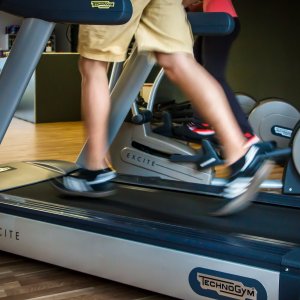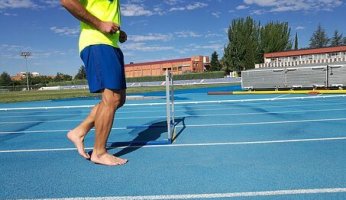How to Increase Your Running Speed
 How to Increase Your Running Speed
gearweare.net
How to Increase Your Running Speed
gearweare.net
There are two primary goals that everyone who runs regularly has – to run farther and to run faster. Logically, if you want to run faster, it is vital to increase your running speed.
For most people who are just starting out, increasing distance is the primary goal. If one hasn’t run a mile in years, getting through that first mile without stopping is definitely something to be proud of. Slowly, as one continues to run, more and more distance can be added and goals can be set. Start with a 5K, then a 10K, a half-marathon, a marathon; there is a natural progression that the majority of people who get into this sport follow. At a certain point, most runners will want to go beyond just adding distance and begin cutting the time that it takes to run those same number of miles.
There are other reasons to work on speed sooner within one’s running career though. For one, training for speed can make running at a slower pace feel downright easy, which will improve the experience of running overall. Furthermore, speed training is anaerobic, which means that the energy used to power this activity is produced by breaking down glucose within the body. This is in contrast to aerobic exercise, which is slower paced and powered by a steady source of oxygen. Distance running at a pace where you can comfortably speak is aerobic exercise.
Aerobic exercise pushes one’s endurance, decreases resting heart rate, and can enhance the efficiency of the movement of red blood cells throughout the body, while anaerobic exercise builds muscle and power, and boosts the body’s ability to take up oxygen under more stress. Training both aerobically and anaerobically will, therefore, make any runner more powerful all around.

While aerobic exercise can be maintained for long periods of time, the high-intensity nature of anaerobic exercise means that they can only be done in short bursts. This is especially true for a beginner, who will not be used to the intense discomfort that comes with doing speed training. For this reason, anyone who hasn’t trained for speed while running should start slow, typically with short sprints that let them become more used to the sensations involved with anaerobic running drills. Starting slow is also important as it eases the body into being able to bear the increased stress of moving more quickly across terrain since starting to fast is a sure-fire way to get injured.
Besides drills, there are also a number of things that a runner can do to begin getting more comfortable with increasing their speed. Some of these tips also make increasing speed feel more natural or decrease the likelihood that a runner will get injured as they up the ante in this way. Below you will find a few more tips for increasing speed while running.
Table of Contents
Work on Form

Before you start working on anything else, work on good form. Bad form will make you less efficient (thereby decreasing your speed) and will increase your chance of injury. Aim for neutral pronation, meaning your ground strike slightly favors the outside of your foot but as you move through the stride you even out your stance so that you push off from the forefoot with weight evenly distributed across the inner and outer sides. Also try to train yourself to strike the ground with the midfoot as opposed to the heel, since heel strikes actively decrease speed.
Body positioning of your upper half is also important for increasing efficiency. Keep your spine upright and your shoulders relaxed. Also, avoid swinging your arms outwards, instead opting for a back and forth motion with the elbows bent at a 90-degree angle.
One great way to improve form is to film yourself running and then watch that video afterward. Set a camera up somewhere you know will be able to capture your movement well or have a friend film you, so you can improve on your process of improving your running speed.
Count Your Steps

The ideal number of steps that a runner should do per minute is 180 – this number creates an efficient cadence that keeps them close to the ground with short, quick steps. However, this is what the most elite runners do and does not need to be everyone’s goal. Getting the number of steps you take in a minute as close as possible to this number will help improve the way any runner used their body though.
To measure how many steps you typically take per minute while running, set a timer then count the number of times of your feet hits the ground as you run. After the minute is up, multiply the number you have counted to by two to find your total steps. Once you know this number you can start working on improving it. Changing your pace in this way will also help you understand the way different paces feel more clearly, which is helpful knowledge for improving your speed.
Run on the Treadmill

Running outside is definitely preferable. In fact, getting outdoors is a major reason why I love running! However, best treadmills do have their place. Besides being a Godsend on freezing, snowy, or rainy days, the can help you experience exactly what a specific pace feels like.
If you have a goal pace that you would like to achieve, set it on the treadmill and run that fast for as long as you can handle it. Get comfortable on the treadmill at a number of other paces as well, including a relaxed pace, which you can do for an elongated period of time as well as a pace that falls somewhere between that and an all-out sprint. Doing this will help you have a clearer idea of how fast you are actually going when you go back outside.
Do Interval Sprints
The only way to run faster is to run faster. This is why sprints are an important part of any training regime meant to improve speed. For those who are truly new to speed training, start with a short sprint at the end of a longer run. Once that starts to feel more comfortable, end with a few of these – run for 20 seconds than do a 30-45 second recovery jog 4-6 times.
As you become better at running fast you can incorporate more and longer sprints into your training at varying speeds. The internet is full of training guides so search around and you are sure to find a regime that works for you.












